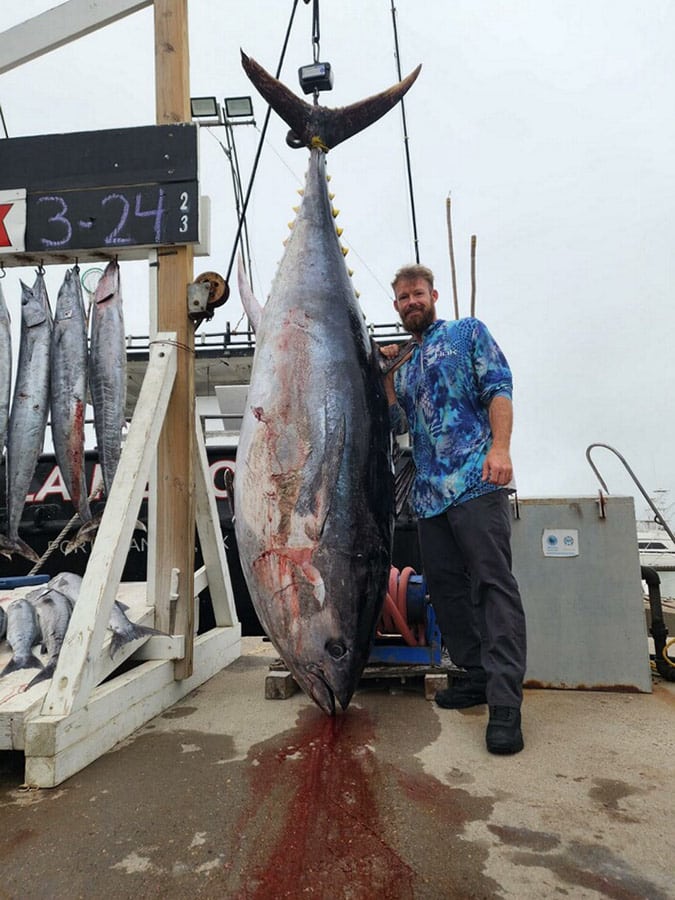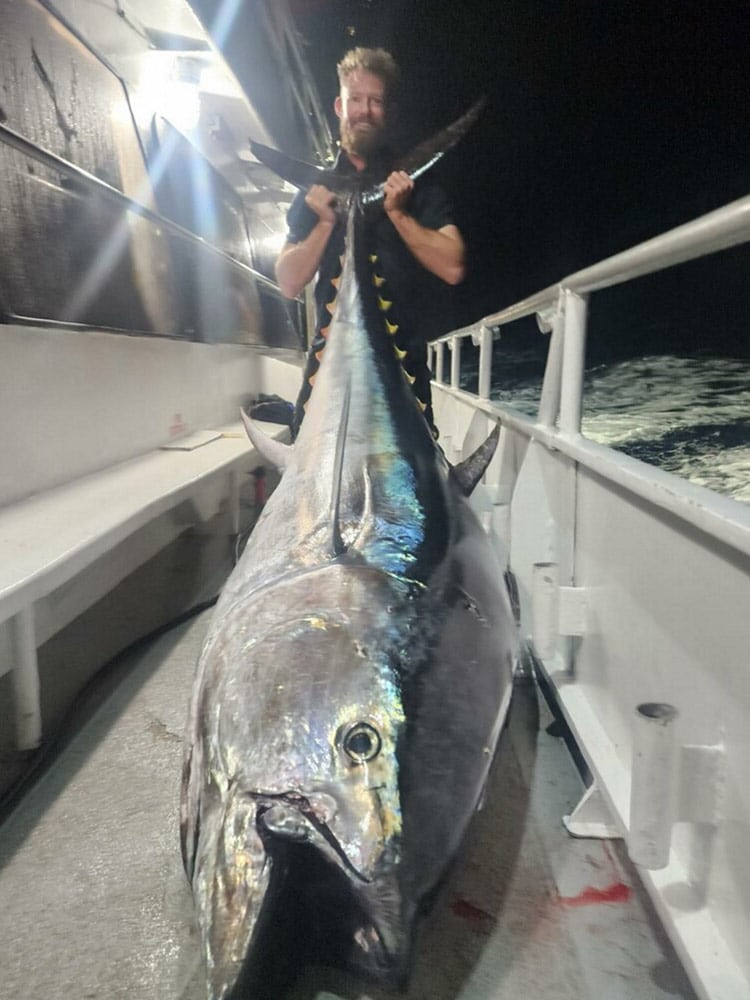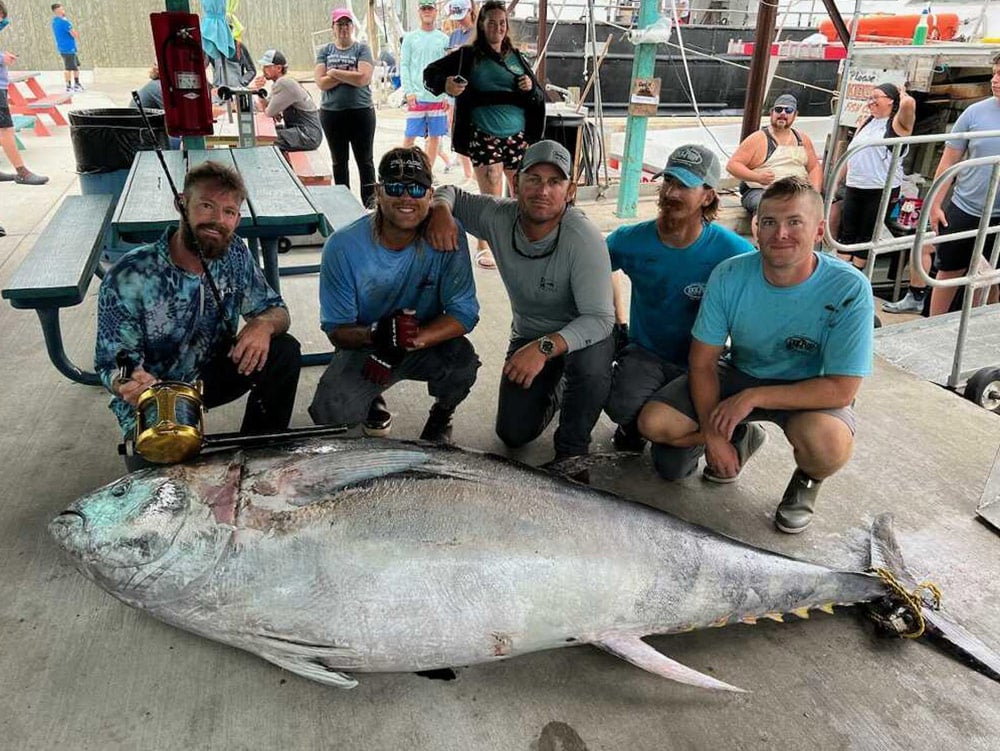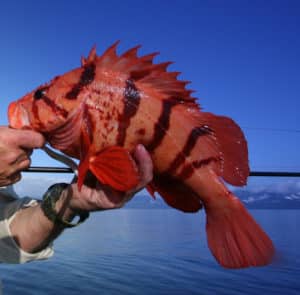
MOST of the people were completely shocked, they couldn’t believe what they saw, said Capt. Tim Oestreich. All he could do was laugh about his customers’ reactions to the 676-pound bluefin tuna they caught on the 95-foot head boat Dolphin Express. But the crew running the Dolphin Express wasn’t surprised — the experienced anglers were ready for anything.
Gulf Coast Long Range Fishing
Oestreich operates an offshore headboat out of Port Aransas, Texas. On his extended 56-hour trips, the 16-angler party targets tuna by casting lures to floating oil rigs in 3,800 to 9,800 feet of water. On an average trip, the boat catches a limit of three yellowfin per person. “I probably land 1,100 tuna every four or five months,” Oestreich said.
In addition to yellowfin and blackfin tunas, Oestreich also catches marlin, wahoo and dolphin. To target blue marlin, he bridles a live blackfin tuna to a 130-class rod and freelines the bait behind the boat. That’s what he was doing when he hooked a massive bluefin tuna that made headlines and blew up fishing social media.
Rigged Up for Oil Rigs
Fishing at the Hoover Diana oil fields, about 130 to 160 miles from Port Aransas, Oestreich said the trip started rough with 6- to 8-foot seas, but the yellowfin tuna were biting.
For tackle, the anglers use a 7-foot conventional rod and Accurate BOSS Extreme 600 two-speed reel. For spin fishers, a 7-foot, 6-inch spinning rod and PENN Slammer III reel is a good option. No matter the setup, anglers on the boat launch a Frenzy Flying Fish or Halco 130 lure into the rig lights.
Oestreich fills the Accurate with 500 yards of 65-pound PowerPro Maxcuatro and adds a 150-foot topshot of 80-pound-test monofilament. For the spinning rod, he uses 80-pound braid and three feet of 80-pound fluorocarbon leader.
Another tactic is chunking bite-size pieces of blackfin. “I probably cut up 60 to 80 blackfin each night,” Oestreich marveled. He fishes the chunks on a 7/0 Mustad semi-circle hook tied to three feet of 80-pound fluorocarbon. “If the tuna are really picky, I’ll go down to 50-pound fluoro leader and a 3/0 hook.”
A Big Bait Equals A Big Bite

While the party was playing with tuna, Oestreich used a 130-pound outfit to drop a live blackfin tuna behind the boat. He spools the reel with 200-pound braided line, a 300-pound topshot and 300-pound fluorocarbon leader. He attaches a 16/0 Owner hook to the end of the top shot and bridles the small tuna.
“The bait was in the water for 10 minutes when we got the bite,” he said.
On the initial run, the big tuna dumped 800 yards of line. Oestreich puts the fish’s feat in perspective, “That’s almost a half mile straight down in about a minute.”
As the fish dumped line, Oestreich figured he had 90 pounds of drag on the reel. “We were running hellacious drag,” he said. Each member of the party took turns reeling on the fish — some people would last two or three minutes before they gave up. “When one angler was done, I would call for fresh meat on the reel,” he joked.
In 45 minutes, they had the fish to the boat, but the tuna took off again.
“You can’t chase a big tuna in deep water or you’ll fight it for hours,” pointed out Oestreich. Instead, he tried to get ahead of the fish, keep the line at an angle and keep the fish moving. He estimated he worked the tuna for two-and-a-half miles. In another 45 minutes they had it next to the boat.
But the tuna wasn’t done. With incredible pressure on the line and the rod in the rod holder, the tuna made a mad dash and snapped his 130-pound rod. Oestreich winced, “That rod cost $1,000.”
The fish was only 40 feet from the boat, so Oestreich jumped on the reel and what was left of the rod. Second captain Matt Murchinson took the boat controls. Mate Dan Haluzen worked the leader. And mates Patrick Simpson and Kurt Jackson manned the gaffs. Everything was under control and the big bluefin tuna was quickly subdued.
Landing a Big Bluefin Tuna on a Head Boat
How do you get a huge tuna onto a headboat? Oestreich was ready for that, too. He attached a snatch block to the tuna’s tail and ran the rope to the upper deck. “We had 8 guys pulling on the rope and the crew using gaffs to guide the fish into the side gate.”
Then they had another problem. The tuna was too big for the fish box, so the crew went to work. “We had to modify the fish box with a saw,” he laughed.
Once the fish was landed, the crew celebrated with hoots, hollers and high-fives, but the party was surprisingly quiet. Oestreich recalled, “I tried to explain to them they had just seen the biggest fish of their lives.”
Preparation Pays Off

The captain credits experience and preparation for making the catch. Two years ago, he landed a 760-pound bluefin on a private charter with one angler. “I’ve been doing this my whole life and the boat holds multiple state and world records,” he said.
He also spent hours prepping gear and maintaining tackle. Keeping an offshore headboat operation running on all cylinders is a group effort. “Before each trip, the whole team is here pulling line off reels and tying leaders,” he said. “The weakest link is the fish’s face — as long as nothing goes wrong, his a** is grass.”
Oestreich says the bluefin show up off Port Aransas in March and stick around through April. The night they landed the 676-pounder they also released a fish he estimated at 500 pounds, plus they pulled the hook on a monster over 800 pounds. A few days after his catch, another boat brought in a 750-pound bluefin. This is Oestreich’s one and only bluefin for the season (Gulf Coast anglers are only allowed to keep one big bluefin each year).
READ NEXT: The Best North Carolina Bluefin Tuna Season in Years








